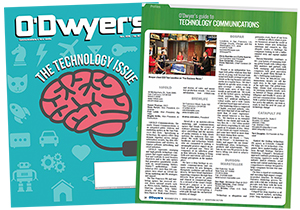|
|
This is where strategic content marketing writing comes into play. Properly performed and executed, content marketing writing helps to achieve those objectives. On the other hand, in many cases, marketing and sales take the tactical rather than strategic approach. In effect, they periodically shovel out random pieces of content to satisfy immediate requirements, instead of performing strategic content marketing on a sustained, organized manner.
|
|
Aside from that, many tech companies are missing the boat by overlooking the importance of content marketing writing as a key element in their PR programs. Or they’re delegating content marketing writing solely to their marketing and sales operations and distinctly separate from PR. Unfortunately, when you separate the two, both entities are less effective. Here’s why:
When content marketing writing is left to marketing, it has a great probability of being polluted given the nature and mindset of marketing and sales in many companies. Generally, that’s because they have a penchant for hyperbole and the classic sales pitch kind of writing. The first thing these individuals want is to promote the product or technology. Content takes on a promotional and hype flavoring that is often annoying and turns customers off simply because they constantly experience product hype so much.
Generally, in the high-tech world, marketing/sales operations stay distant from PR, allowing them limited time to source new product announcement information. Sometimes, that’s done via brief emails touting new features, and leaving the PR pro to craft the press release.
Also marketing and sales often lacks a content strategy and relies heavily on specific and random sales tools they often feel will work for them, such as advertisements, email, social media, etc.
Most often, marketing and sales produce company-centric content, rather than the more vital customer-centric content. Studies show that prospects come to websites searching for answers to their hardware or software issues. This is where journalistic customer-centric content plays a major role, and the burden should be on the PR pro to provide this valuable marketing content.
However, in some cases, the inexperienced PR or Communications Chief solely relies on the company’s CEO’s “vision” and adopts it as the content strategy without involving marketing and sales. The issue here is that the CEO’s company-centric Vision might indeed be an effective roadmap of how his/her company evolves. However, it’s definitely not customer-centric, and at best, it’s a faux content strategy since marketing and sales customer input is missing.
Improperly defining a content strategy is related to the misguided or ill defined one described above. To be effective, a correct content strategy must be in sync with and not divergent from a well-defined business strategy.
Another obstacle is focusing solely on tactical marketing and sales tools like product briefs, datasheets, brochures, and other sales support documents. These docs are the lifeblood of sales people and they want them right now. Hence, so-called content marketing stays in that realm with strategy becoming non-existent.
High-tech marketing and sales and PR, as well, often take their cue from consumer social media with the faulty assumption that resulting buzz from social media will establish marketing strategies and achieve their sales generation goals.
Social media with its limited amount of content may be fine for stable, consumer products. However, technology is not stable; rather, it’s dynamic. It continually grows, expands, advances, etc. It definitely is not static.
Fueling content marketing
A high-tech company, regardless whether it’s a giant or a start up, must continue to educate its audiences or personas as referred to today. The PR objectives in educating audiences are to build trust, confidence, credibility and reputation about new technologies.
Consider the rapidly rising tide of the Internet of Things. A few years ago, it wasn’t in the tech lexicon. Then all of a sudden, a Silicon Valley networking giant sparked the term saying, “There were more things connected to the Internet than people.” And the term took off with the trade press increasingly putting major editorial interest in IoT.
Today, there are about 20 major tech giants vying for business in the IoT platform arena. Each has its own software and hardware technologies to support new customers. As a result, educating those markets is critical.
Social media definitely plays a role in a high-tech PR and con- Dan Garza tent marketing strategy.
However, many inexperienced marketing and media relations professionals in technology today lean heavily on social media and the so-called “bite size or snack-able” content to “generate buzz” in hopes of getting customer buy in for the products they’re marketing.
Unfortunately, social media isn’t substantially structured to deliver the critical long-form of content. Neil Patel, writing for the Content Marketing Institute in May, said, “Long-form content as opposed to “snack-able” content is what fuels a successful con-tent marketing approach.”
In the high-tech world, subject matter is dynamic and generally never static. That means the PR pro has to maintain a comprehensive and sustained marketing con-tent program to constantly educate his/her B2B audiences. Hence, there’s the right way and the wrong way.
Let’s take the wrong way first. Some marketing and PR pros are prone to first go to social media to try to get their educational content to targeted customers. An example is the marketing chief who felt his audience wouldn’t be able to understand a new soft-ware technology.
It was just too complex, he asserted. Therefore, in his way of thinking, it would be best to first do a “social tile” to slowly and cautiously start introducing the technology to prospective customers. He fretted that loading up customers with too much technical information would drive them away.
Think about it: a “social tile,” whether it’s on Facebook or Twitter, provides the PR pro very little space for content. You can’t shoehorn a lot of strategic content in that tiny space. So, it’s not an effective customer communications channel for educational purposes.
Circle closer toward purchase
On the other hand, when a new technology or enhanced versions of an earlier technology is ready to be launched, the PR pro comes out with both guns blazing after crafting the right content marketing strategy. Patel again says it best in his article not-ed above:
“In the marketing funnel itself, long-form content — usually the deep stuff — is what helps users circle closer toward a purchase, encourages loyalty, and improves user experience.”
The idea behind this PR/content marketing strategy is to use the right tool at the right time. For example, the stage can be set out in time for a major product or technology launch to condition prospective and existing customers to more favorably accept the new product or technology. That approach doesn’t actually announce a product, but it finesses strategic and valuable content to targeted prospects. Plus, it helps to fend off competition, while your content erects barriers and questions associated with competitive products and technologies.
You can’t do that through social media; rather, the key PR toolbox in this instance is an array of long-form, strategically executed marketing content like contributed by-line articles, blogs, white papers, conference tech papers, and op-eds.
The 2016 B2B Buyer’s Survey discovered, among other key findings, that the majority of respondents believe “relevant content that speaks directly to my company” is the single most influential aspect of any vendor’s website. Creating that relevant content in both long- and short-form falls on the shoulders of the PR pro.
***
Dan Garza is a marketing PR professional and veteran observer of Silicon Valley PR.




 Laura Anderson, who rose to VP/GM of global communications and events in a nearly 20 year stint at Intel, will take on the Americas technology chair at Burson following the completion of the BCW and H+K merger on July 1.
Laura Anderson, who rose to VP/GM of global communications and events in a nearly 20 year stint at Intel, will take on the Americas technology chair at Burson following the completion of the BCW and H+K merger on July 1. WE Communications has partnered with ROKK Solutions to form the WE ROKK AI service.
WE Communications has partnered with ROKK Solutions to form the WE ROKK AI service. In the dynamic world of modern business, effective communication is a pivotal tool for success across various industries. At Communications Strategy Group (CSG®), our expertise in embracing innovation in communication extends beyond traditional marketing strategies, paving the way for transformative industry-specific solutions.
In the dynamic world of modern business, effective communication is a pivotal tool for success across various industries. At Communications Strategy Group (CSG®), our expertise in embracing innovation in communication extends beyond traditional marketing strategies, paving the way for transformative industry-specific solutions. There are two types of tech PR professionals. Which one are you? And are C-suite executives making that decision for you?
There are two types of tech PR professionals. Which one are you? And are C-suite executives making that decision for you? While there’s an impulse to grab reporters’ attention with the newest industry-transforming tech product or service, a back-to-basics approach focused on telling the right stories to the right people is a far more successful way to ensure your technology campaign breaks through the clutter of today’s crowded tech landscape.
While there’s an impulse to grab reporters’ attention with the newest industry-transforming tech product or service, a back-to-basics approach focused on telling the right stories to the right people is a far more successful way to ensure your technology campaign breaks through the clutter of today’s crowded tech landscape.


 Have a comment? Send it to
Have a comment? Send it to 
No comments have been submitted for this story yet.